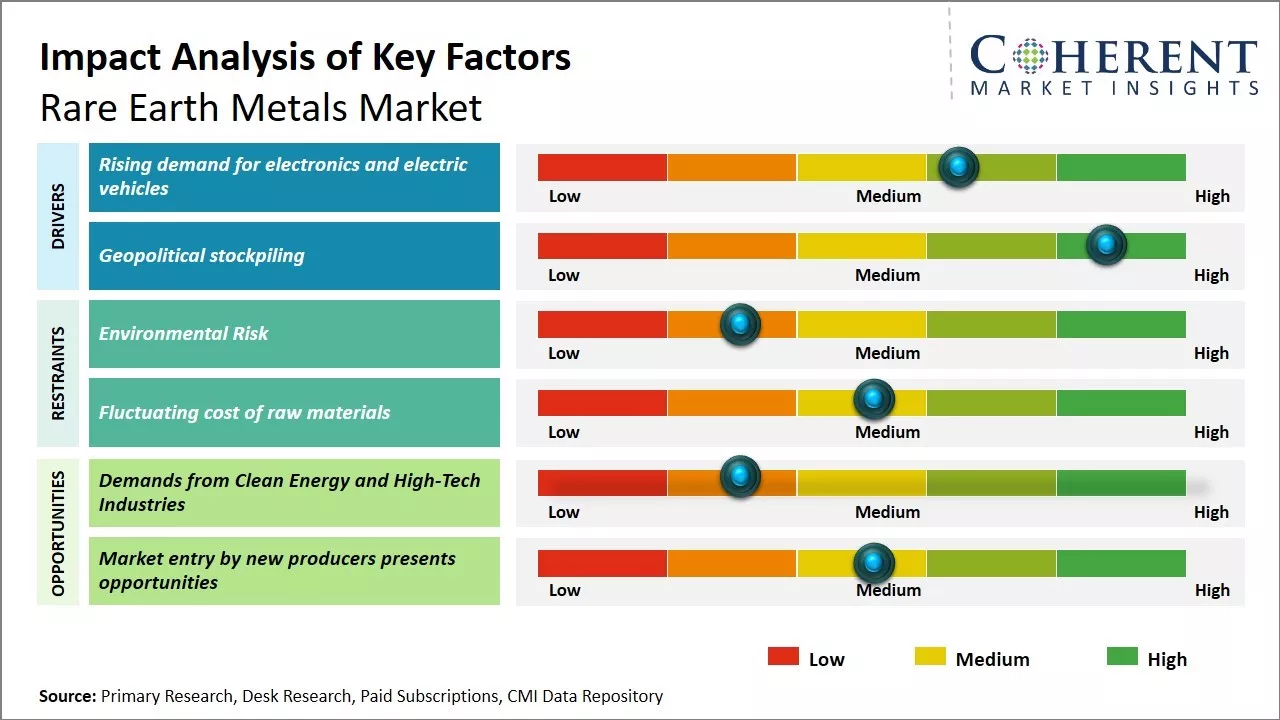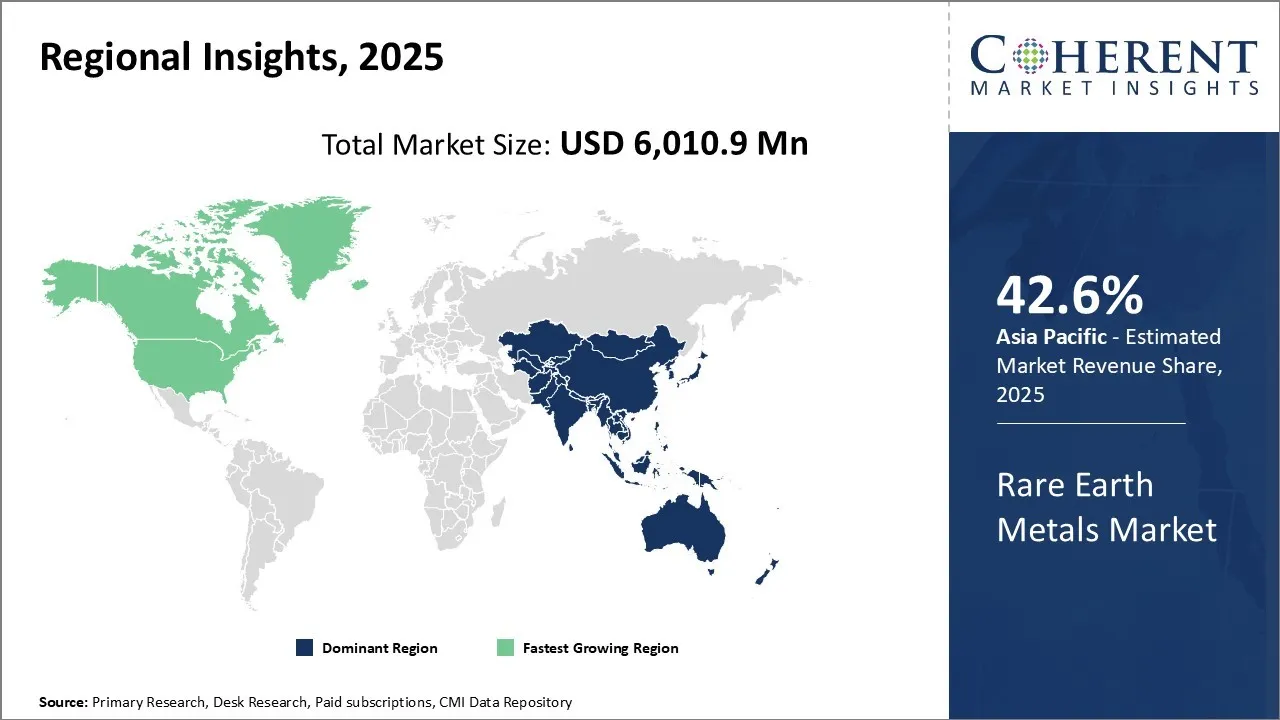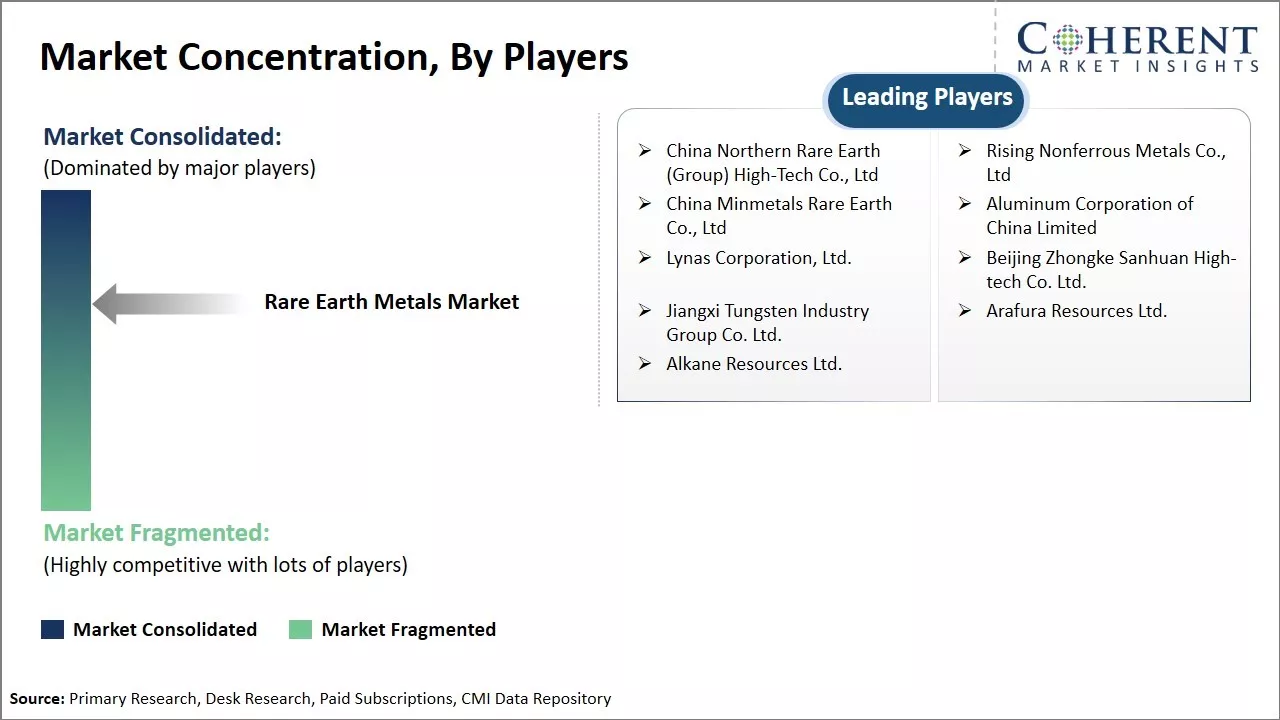Global rare earth metals market is estimated to be valued at USD 6,010.9 Mn in 2025 and is expected to reach USD 9,285.8 Mn by 2032, exhibiting a compound annual growth rate (CAGR) of 6.4% from 2025 to 2032.

To learn more about this report, Download Free Sample
The demand for rare earth metals is expected to grow steadily during the forecast period. Rare earth metals are crucial components in many modern technologies and their usage is growing across various application industries such as automotive, manufacturing, consumer electronics, and others. The electric vehicles market in particular is projected to boost demand for rare earth metals as these are used extensively in manufacturing of batteries and motors for EVs. Further, increasing manufacturing activity around the world and growing demand for electronics like smartphones is also expected to boost consumption of rare earth metals in coming years.
|
Current Event |
Description and its Impact |
|
U.S.-China Trade Relations and Export Controls |
|
|
Electric Vehicle Market Expansion |
|
Uncover macros and micros vetted on 75+ parameters: Get instant access to report
Global rare earth metals market is expected to witness growth significantly in the near future due to rising demand for electronic products as well as electric vehicles across the globe. Rare earth metals such as neodymium, praseodymium, and dysprosium which are essential components in manufacturing magnets, find widespread application in consumer electronics ranging from smartphones, laptops, headphones to speakers.
With growing digitalization and increasing dependency on electronic devices, the demand for consumer electronics has witnessed a robust growth trajectory over the past decade. The demand is expected to further accelerate with the rollout of next-generation technologies like 5G networks, artificial intelligence, and quantum computing. As electronics become more advanced with miniaturization of components and high-performance specifications, rare earth magnets play a vital role.
This growing dependence on rare earths in electronics will be a key factor supporting the expansion of the rare earth metals market. Electric vehicles require rare earth permanent magnets in their traction motors for torque and power qualities needed for acceleration. With tightening emission regulations and push for sustainability, global EV sales have picked up pace in recent years.
Growing concern of supply security and geopolitical stockpiling among major consumer nations is expected to drive the market growth. China dominates the global rare earth supply chain accounting for over 80% of production. This heavy reliance on China makes supply vulnerable to any trade restrictions or supply disruptions, as was evident during the China-Japan trade war a few years ago. There are also environmental and resource nationalization risks arising from Chinese policies. These supply risks have prompted countries like the U.S., Japan, Europe to focus on diversifying supply and developing domestic production.
Neodymium is considered the most widely used rare earth metal, contributing around 38.1% share of the market. Neodymium finds its key usage in the production of neodymium-iron-boron permanent magnets which are utilized across a wide range of applications from home appliances to electric vehicles. Permanent magnets contain neodymium elements that allow them to maintain their magnetic properties for an extended period with no external power source required.
This makes neodymium an indispensable input material for manufacturing of permanent magnets. Some of the major factors boosting demand for neodymium include the increased use of permanent magnets in modern consumer electronics such as headphones, computer hard drives, and motors of electric vehicles due to their high-energy product and resistance to demagnetization.
Rapid adoption of renewable energy technologies like wind turbines and electric vehicle powertrains that extensively use permanent magnets is also positively impacting the neodymium consumption. Further, neo magnets offer cost-effective and lightweight magnetic solutions in comparison to electromagnets. This property encourages industries to substitute conventional magnets with neodymium varieties.
For instance, in October 2025, the Pentagon launched an ambitious effort to procure up to $1bn worth of critical minerals as part of an accelerated stockpiling programme designed to counter Chinese control of materials essential to defence manufacturing.
Permanent magnets dominate the rare earth metals market, accounting for over 40.5% of market share. These find extensive industrial applications ranging from consumer electronics to renewable energy equipment. Some key factors boosting demand for permanent magnets include miniaturization of electronics devices requiring compact and high-flux magnets. Integrating permanent magnets provides an optimized solution.
Furthermore, permanent magnet synchronous motors have higher efficiency over traditional motors and are being increasingly adopted across industries including HVAC, white goods and automobiles. Renewable energy generation through wind turbines is another major application area fueling the magnet usage.
Large direct drive wind turbines employ permanent magnet generators that optimize energy output. Additionally, electric vehicles are undergoing rapid popularization necessitating high-capacity battery packs and electric motors made possible by permanent magnets.
For instance, in October 2025, Noveon Magnetics, the only operational U.S. manufacturer of sintered rare earth magnets, and Lynas Rare Earths, the world's only commercial producer of separated light and heavy rare earth oxides outside of China, signed a Memorandum of Understanding (MoU) to form a strategic partnership aimed at establishing a scalable and domestic U.S. supply chain for rare earth permanent magnets.

To learn more about this report, Download Free Sample
Asia Pacific contributed 42.6% share of the global rare earth metals market owing to its rich rare earth reserves and control over supply. It accounts for the major share of worldwide rare earth oxide production. The mountains of Southern China have been a major source of rare earths for decades.
Chinese companies dominate rare earth mining and the country hosts a strong manufacturing base that utilizes these crucial minerals. It has strategically developed downstream rare earth processing and alloy making capacities over the years. This vertically integrated supply chain allows China to dictate prices in the global market. While other nations are trying to reduce dependence on China, it will take considerable time and investment for anyone to match China's production capabilities and market control.
For instance, in June 2025, Attero announced a significant scale-up of its rare earth elements (REE) recycling capacity to 30,000 tonnes from 300 tonnes, over the next 12 to 24 months by investing INR 100 crores. Such innovations are accelerating the rare earth metals market demand.
North America has emerged as the fastest growing region in the rare earth metals market. Countries like the U.S. and Canada are boosting exploration of rare earth deposits and ramping up processing capacities. Supportive government policies and funding for indigenous rare earth industries is aiding regional growth. Several mining projects are underway to secure domestic supply of rare earths. Investments are also flowing into rare earth magnet and alloy production facilities.
North America has a sizable consumer electronics and electric vehicle industry that depends on rare earth inputs. Hence, there is a strategic push to develop alternative regional sources and minimize Chinese imports over time. International collaborations between North American and allied nations will likely strengthen non-Chinese supply sources going forward.
For instance, in August 2023, the U.S. Department of Energy (DOE) announced its intent to issue notices of funding opportunities (NOFO) totaling nearly $1 billion to advance and scale mining, processing, and manufacturing technologies across key stages of the critical minerals and materials supply chains.
The U.S. is estimated to hold highest share in the global rare earth metals market during the forecast period, owing to increasing investments in domestic mining, processing, and refining capabilities aimed at reducing dependence on foreign supply, particularly from China. Government initiatives, strategic stockpiling, and funding under critical minerals policies are accelerating the development of a secure and self-reliant rare earth supply chain.
In August 2025, Rare Earths Americas (REA) announced its establishment along with plans to develop and explore high-grade heavy rare earth mineral deposits in the United States and Brazil, following a successful private fundraising round of AU$25 million (around US$16 million).
China is estimated to hold largest share in the global rare earth metals market during the forecast period, owing to its vast reserves, well-established mining and refining infrastructure, and strong government support for the rare earth industry. The country leads in the production and export of key rare earth elements used in magnets, batteries, and electronics, and controls a significant portion of the global processing capacity.

To learn more about this report, Download Free Sample
| Report Coverage | Details | ||
|---|---|---|---|
| Base Year: | 2024 | Market Size in 2025: | USD 6,010.9 Mn |
| Historical Data for: | 2020 To 2024 | Forecast Period: | 2025 To 2032 |
| Forecast Period 2025 to 2032 CAGR: | 6.4% | 2032 Value Projection: | USD 9,285.8 Mn |
| Geographies covered: |
|
||
| Segments covered: |
|
||
| Companies covered: |
China Northern Rare Earth (Group) High-Tech Co., Ltd, Rising Nonferrous Metals Co., Ltd, China Minmetals Rare Earth Co., Ltd, Aluminum Corporation of China Limited, Lynas Corporation, Ltd., Beijing Zhongke Sanhuan High-tech Co. Ltd., Jiangxi Tungsten Industry Group Co. Ltd., Arafura Resources Ltd., Alkane Resources Ltd. |
||
| Growth Drivers: |
|
||
| Restraints & Challenges: |
|
||
Uncover macros and micros vetted on 75+ parameters: Get instant access to report
The demands from clean energy and high-tech industries ensure opportunities for growth. Electric vehicles, wind turbines and smart devices require rare earth components in their design and manufacturing. Investments into recycling could secure a secondary supply of rare earths. Countries are exploring reserves within their borders to diversify supply.
*Definition: Rare earth metals market involves the production, trade and consumption of rare earth metals and metals derived from rare earth elements. Rare earth metals are valued for their unique magnetic and electrochemical properties and have various industrial and technology applications. This market covers the mining and extraction of rare earth elements from the earth's crust as well as the further refining, alloying and fabrication of rare earth metals into components and products for industries such as automotive, aerospace, semiconductor manufacturing, renewable energy technology, optics and more
Share
Share
About Author
Yash Doshi is a Senior Management Consultant. He has 12+ years of experience in conducting research and handling consulting projects across verticals in APAC, EMEA, and the Americas.
He brings strong acumen in helping chemical companies navigate complex challenges and identify growth opportunities. He has deep expertise across the chemicals value chain, including commodity, specialty and fine chemicals, plastics and polymers, and petrochemicals. Yash is a sought-after speaker at industry conferences and contributes to various publications on topics related commodity, specialty and fine chemicals, plastics and polymers, and petrochemicals.
Missing comfort of reading report in your local language? Find your preferred language :
Transform your Strategy with Exclusive Trending Reports :
Frequently Asked Questions
Joining thousands of companies around the world committed to making the Excellent Business Solutions.
View All Our Clients